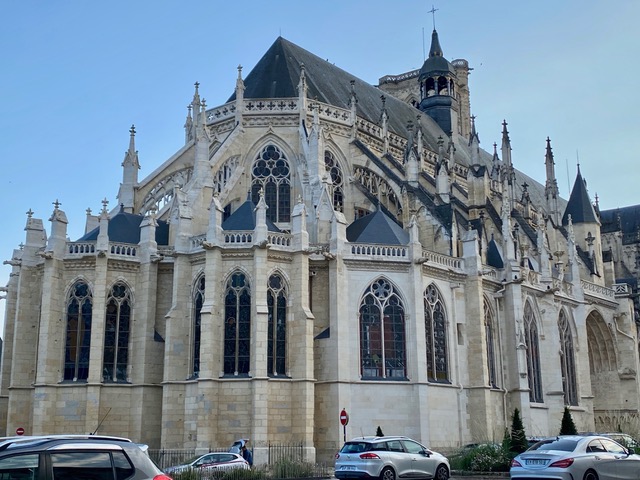Our goal this year was to cruise to Sancerre, a Medieval hilltop town overlooking the Loire River. We have such fond memories of our last visit. Sancerre wine is one of my favorites, and the area is also known for its fabulous goat cheese. There is a wonderful Michelin starred restaurant in the center of town we looked forward to dining at again. Unfortunately Sancerre was too far for us with our limited time in France this year. Instead we cruised to Nevers and drove to Sancerre. We were not disappointed.
The town of Nevers is filled with architecture, history and art.
We crossed the bridge to enter the town of Nevers. The Cathedral of Saint-Cyr-et-Sainte-Juliette dominates the town.
 The Loire Bridge in Nevers was designed in 1767 but not completed until 1832.
The Loire Bridge in Nevers was designed in 1767 but not completed until 1832.
Back corner of the Cathedral
 |
| As you can see from this photo the Cathedral was heavily damaged during WWII. It was built in the 10th century and modified in the 16th century. |
Interior of the Cathedral. The new modern stained glass windows cast a warm glow.
This watch tower was built in the XV century.
13th century windows characteristic of the Gothic period.
 |
Throughout the town we found old timbered homes.
|
We loved seeing the kids canoeing in the Port de Plaisance (marina) in Nevers.
 |
La Tour restaurant in Sancerre. A fabulous meal with a delicious bottle of Sancerre (red) wine. While Sancerre is famous for their white wine, they do produce excellent reds as well.

Squash and plum, smoked herring caviar cream

Beef fillet, candied figs, baby carrots and scallion juice
They put together a gluten free dessert for me.

Walking around the town of Sancerre. The streets have maintained their medieval layout. Sancerre has been classified as a tourist town, hence there are no factories or industry.
 | A charming side street in Sancerre. There are still homes standing from the 15th Century.
|

Views everywhere

Fields surrounding Sancerre. |
One day we had lunch outside at a restaurant, and this was our view. The meal wasn’t great but the location made up for it plus a bottle of wine didn’t hurt.
 |
During a walk in Digoin we found a clever artist.

A detail of this artist’s work using junk they have acquired.
|
 |
| Cruising the Canal Lateral a la Loire one never knows what we will find around the next bend. |

On one of our daily walks we saw this restaurant on the other side of the canal. We had a delicious dinner there on a cold rainy evening.










































































